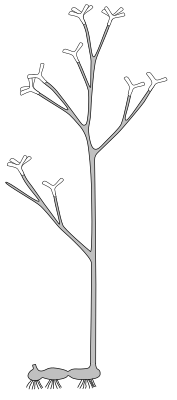Horneophyton lignieri
| Horneophyton lignieri | ||||||||||||
|---|---|---|---|---|---|---|---|---|---|---|---|---|

Drawing reconstruction |
||||||||||||
| Temporal occurrence | ||||||||||||
| Devon , Emsium / Eifelium | ||||||||||||
| approx. 396 ± 8 million years | ||||||||||||
| Locations | ||||||||||||
| Systematics | ||||||||||||
|
||||||||||||
| Scientific name | ||||||||||||
| Horneophyton lignieri | ||||||||||||
| ( Kidst. & WHLang ) Bargh. & Darrah |
Horneophyton lignieri is a fossil plant species that wasfirst described in1920 from the Rhynie Chert in the Scottish county of Aberdeenshire . She alone forms the genus Horneophyton . She has no real vessels. Their sporangia are branched.
features
Sporophyte
The rhizome is relatively large, lobed to bulbous and parenchymatic . It carries numerous, unicellular rhizoids .
The axes are up to 20 centimeters high and branch out forked (dichotomous). They are not in one plane (planar). They form small multicellular growths. The axis is a protostele . The water-conducting elements have no clear thickenings that would clearly identify them as tracheids . The conductive cells in the center are narrower than the outer ones. Around this central cord is a ring of thin-walled cells, further outside a cortical zone. The epidermis consists of elongated cells and has a well-defined cuticle . The stomata are at the tip of the small growths, both on the axis and on the sporangia.
The sporangia are terminal on the axes. They are cylindrical, hardly distinguishable from the axis. They have a central sterile axis (columella) inside. The sporangia branch out two or three times in a nonplanar manner, with the sporogenic tissue being continuous. The sporangia likely opened with an apical slit. The microspores are 39 to 71 micrometers in size, trilet (with a three-pointed scar), rounded and apiculate.
Gametophyte
Langiophyton mackiei has been identified as a likely female gametophyte from Horneophyton . It probably grew autotrophically above ground. The axis ends in a shield-shaped structure 10 millimeters in diameter on which around 30 short, archegonia- bearing axes sit. The archegonia have a sunken egg chamber and a massive archegonia neck. The connection to Horneophyton is based on the same structures of the lead cells, the epidermis and the stomata. The vascular tissue branches out in the apical shield, with each vascular bundle extending into an archegonia-bearing axis.
ecology
Horneophyton grew on sandy soils that were rich in organic matter. Often they grew individually, mostly on damp to wet locations.
Systematic position
Horneophyton was added to the Rhyniophytes by Harlan P. Banks . Cladistic studies have shown, however, that due to the lack of clear tracheids, it does not belong to the vascular plants and therefore not to the rhyniophytes. Paul Kenrick and Peter R. Crane have therefore put the genus together with Caia and Tortilicaulis , which also have branched sporangia, in a separate group Horneophytopsida. This group is the sister group of the clade ( Aglaophyton + vascular plants).
Botanical history
Horneophyton was described as Hornea by Robert Kidston and WH Lang in their series of publications on the fossils from the Rhynie Chert in 1920 , but had to be renamed by Barghoorn and Darrah in 1938 because Hornea was already taken. In 1991 the female gametophyte was described by Remy and Hass.
supporting documents
- Paul Kenrick, Peter R. Crane: The Origin and Early Diversification of Land Plants. A Cladistic Study . Smithsonian Institution Press, Washington DC 1997, pp. 319f. ISBN 1-56098-729-4
- Thomas N. Taylor, Edith L. Taylor: The Biology and Evolution of Fossil Plants . Prentice Hall, Englewood Cliffs 1993, pp. 199f. ISBN 0-13-651589-4
Individual evidence
- ↑ Paul Selden , John Nudds: Window on Evolution. Famous fossil sites in the world . Elsevier Spektrum Akademischer Verlag, Munich 2007, p. 53. ISBN 978-3-8274-1771-8
- ↑ Kenrick, Crane: The Origin and Early Diversification of Land Plants , 1997, Fig. 4.31; Peter R. Crane, Patrick Herendeen, Else Marie Friis: Fossils and Plant Phylogeny . In: American Journal of Botany , Volume 91 (10), 2004, pp. 1683-1699.